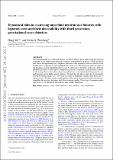Dynamical tides in coalescing superfluid neutron star binaries with hyperon cores and their detectability with third-generation gravitational-wave detectors
Author(s)
Yu, Hang; Weinberg, Nevin N
DownloadAccepted version (488.7Kb)
Terms of use
Metadata
Show full item recordAbstract
© 2017 The Author. Published by Oxford University Press on behalf of the British Society for Antimicrobial Chemotherapy. All rights reserved. The dynamical tide in a coalescing neutron star binary induces phase shifts in the gravitational waveform as the orbit sweeps through resonances with individual g-modes. Unlike the phase shift due to the equilibrium tide, the phase shifts due to the dynamical tide are sensitive to the stratification, composition and superfluid state of the core. We extend our previous study of the dynamical tide in superfluid neutron stars by allowing for hyperons in the core. Hyperon gradients give rise to a new type of composition g-mode. Compared to g-modes due to muon-to-electron gradients, those due to hyperon gradients are concentrated much deeper in the core and therefore probe higher density regions. We find that the phase shifts due to resonantly excited hyperonic modes are ~10-3 rad, an order of magnitude smaller than those due to muonic modes. We show that by stacking events, third-generation gravitational-wave detectors should be able to detect the phase shifts due to muonic modes. Those due to hyperonic modes will, however, be difficult to detect due to their smaller magnitude.
Date issued
2017Department
Massachusetts Institute of Technology. Department of Physics; MIT Kavli Institute for Astrophysics and Space Research; LIGO (Observatory : Massachusetts Institute of Technology)Journal
Monthly Notices of the Royal Astronomical Society
Publisher
Oxford University Press (OUP)